Database Plugin - Macros - Execute SQL and SQL script¶
Contents :
# EXECUTE_SQL {file} ON {database} AS {result}¶
What ?
This macro will load and execute an SQL query against the database, then the result will be returned under the name you typed for the last parameter.
Underlying instructions :
LOAD {file} AS __temp{%%rand1}.file
CONVERT __temp{%%rand1}.file TO file(param.relativedate) AS __temp{%%rand2}.file
CONVERT __temp{%%rand2}.file TO query.sql(query) AS __temp_{%%rand3}.query
EXECUTE execute WITH __temp_{%%rand3}.query ON {database} AS {result}
> Input :
{file}: A SQL query (‘.sql’).{database}: The name (in the context) of the database to use (databasetype target).
Remark : The {file} must respect the same rules than a file which would serve to create an SKF query.sql type resource via the converter (From file to query.sql).
> Output :
{result}: The name of the resource which will contain the result of the SQL query(result.sqltype resource).
Example :
# EXECUTE_SQL path/to/query1.sql ON my_database AS result
Example with an INSERT query :
Database overview :
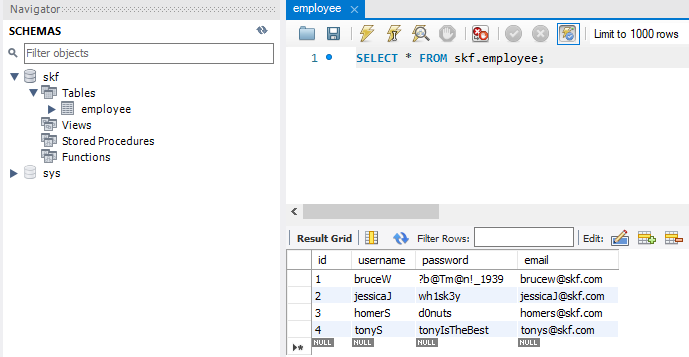
.sql file for the query :

SKF script :

The new employee has been inserted in the database :
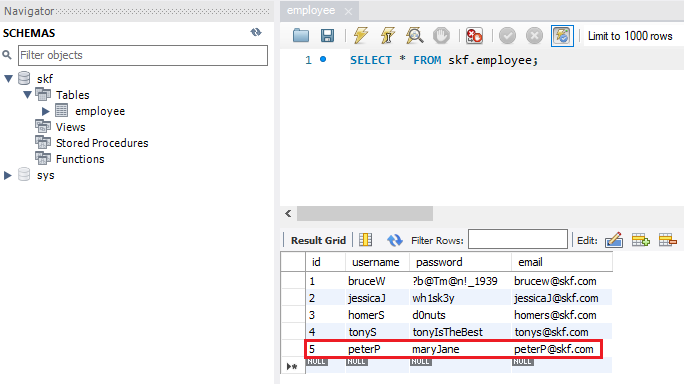
Example with a SELECT query :
.sql file for the query :
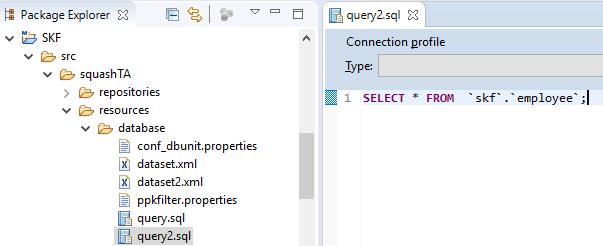
SKF script :

To be able to see the result output, we added in this example the following instructions :
CONVERT result TO dataset.dbunit (dataset) USING $(tablename : user) AS dataset CONVERT dataset TO xml (dbu.xml) AS my_xml_fileYou can access to the result output in the following folder which contains temporary files :


Result output :

# EXECUTE_SQL_SCRIPT {file} ON {database} AS {result} WITH ENCODING {encoding} AND DELIMITER {delimiter}¶
What ?
This macro will load and execute an SQL script against the database, then the result will be returned under the name you typed for the last parameter.
Underlying instructions :
LOAD {file} AS __temp{%%rand1}.file
DEFINE $(encoding:{encoding}) AS encoding{%%rand1}.opts
DEFINE $(delimiter:{delimiter}) AS delimiter{%%rand1}.opts
CONVERT __temp{%%rand1}.file TO file(param.relativedate) AS __temp{%%rand2}.file USING encoding{%%rand1}.opts
CONVERT __temp{%%rand2}.file TO script.sql AS __temp_{%%rand3}.script USING encoding{%%rand1}.opts, delimiter{%%rand1}.opts
EXECUTE execute WITH __temp_{%%rand3}.script ON {database} AS {result}
> Input :
{file}: An SQL script{database}: The name (in the context) of the database to use (databasetype target).- Optional -
{encoding}: Parameter representing the query file encoding. Default value : “UTF-8”.- Optional -
{delimiter}: Parameter representing the SQL block delimiter. Default value : “@@”. It can be used in conjunction with {encoding} or by itself - in which case {encoding} will take its value by default.
Remark : The {file} must respect the same rules as a file used to create an SKF script.sql type resource via the converter (From file to script.sql).
> Output :
{result}: A free identifier for the result. As the ‘execute’ command with an sql script return an empty resource, this result resource will also be empty.
Example :
# EXECUTE_SQL_SCRIPT path/to/script.sql ON my_database AS result WITH ENCODING UTF-16 AND DELIMITER $$$ script.sql file :
DROP TABLE IF EXISTS `skf`.`employee`; CREATE TABLE `skf`.`employee` ( `id` INT NOT NULL AUTO_INCREMENT, `username` VARCHAR(45) NULL, `password` VARCHAR(45) NULL, `email` VARCHAR(45) NULL, PRIMARY KEY (`id`)); INSERT INTO `skf`.`employee` (`username`, `password`, `email`) VALUES ('bruceW', '?b@Tm@n!_1939', 'brucew@skf.com'); INSERT INTO `skf`.`employee` (`username`, `password`, `email`) VALUES ('jessicaJ', 'wh1sk3y', 'jessicaJ@skf.com'); INSERT INTO `skf`.`employee` (`username`, `password`, `email`) VALUES ('homerS', 'd0nuts', 'homers@skf.com'); INSERT INTO `skf`.`employee` (`username`, `password`, `email`) VALUES ('tonyS', 'tonyIsTheBest', 'tonys@skf.com'); INSERT INTO `skf`.`employee` (`username`, `password`, `email`) VALUES ('çàééééééèèèèèè', 'ççççççééééééé', 'test');We encode the file in ISO-8859-1 and use special characters :

SKF script :

Database overview without specifying encoding in macro :
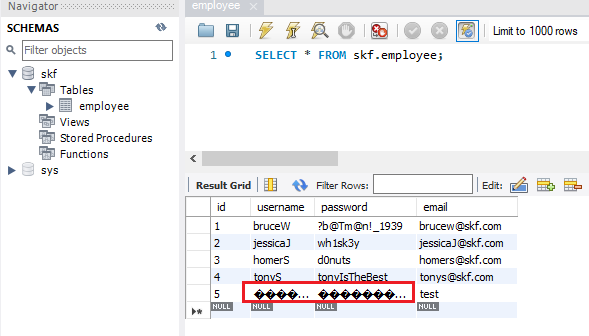
SKF script :

Database overview with encoding :
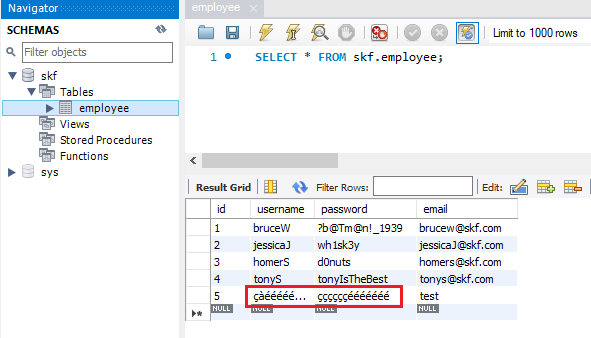
#EXECUTE_SQL_SCRIPT_BY_REMOVING_SEPARATOR {file} ON {database} AS {result}¶
What ?
This macro will load and execute an SQL script against the database, then the result will be returned under the name you typed for the last parameter. The separator (“;”) at the end of each SQL query of the script will be removed.
Underlying instructions:
LOAD {file} AS __temp{%%rand1}.file
CONVERT __temp{%%rand1}.file TO file(param.relativedate) AS __temp{%%rand2}.file
CONVERT __temp{%%rand2}.file TO script.sql AS __temp_{%%rand3}.script
EXECUTE execute WITH __temp_{%%rand3}.script ON {database} USING $(keep.separator:false) AS {result}
> Input :
{file}: An SQL script.{database}: The name (in the context) of the database to use (databasetype target).
Remark : The {file} must respect the same rules than a file which would serve to create an SKF script.sql type resource via the converter (From file to script.sql).
> Output :
{result}: A free identifier for the result. As the ‘execute’ command with an sql script returns an empty resource, this result resource will also be empty.
Example :
| # EXECUTE_SQL_SCRIPT_BY_REMOVING_SEPARATOR path/to/my_script.sql ON my_database AS result |